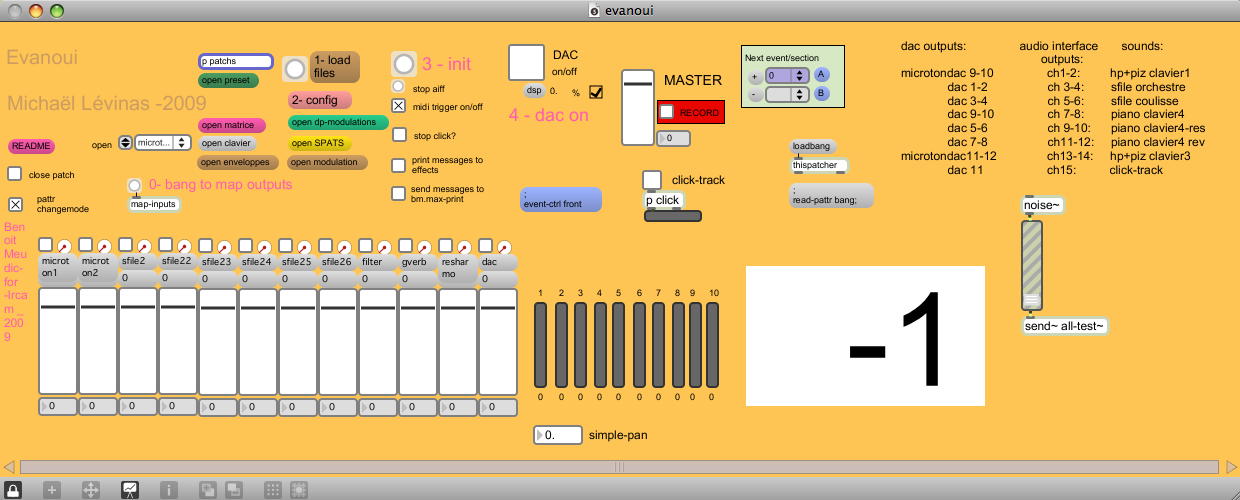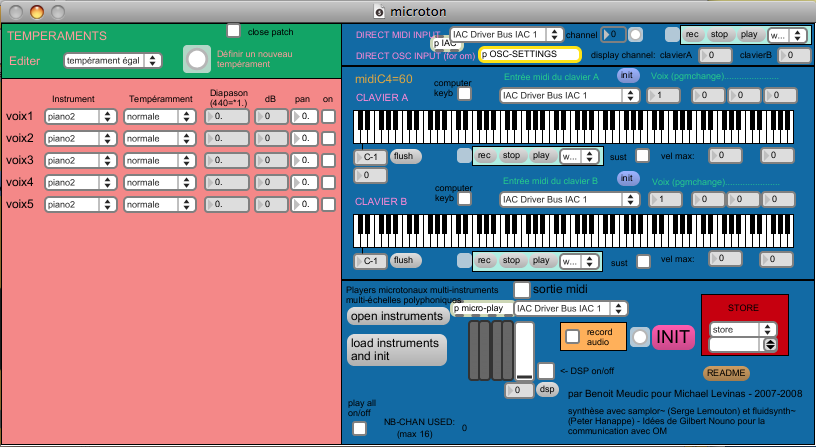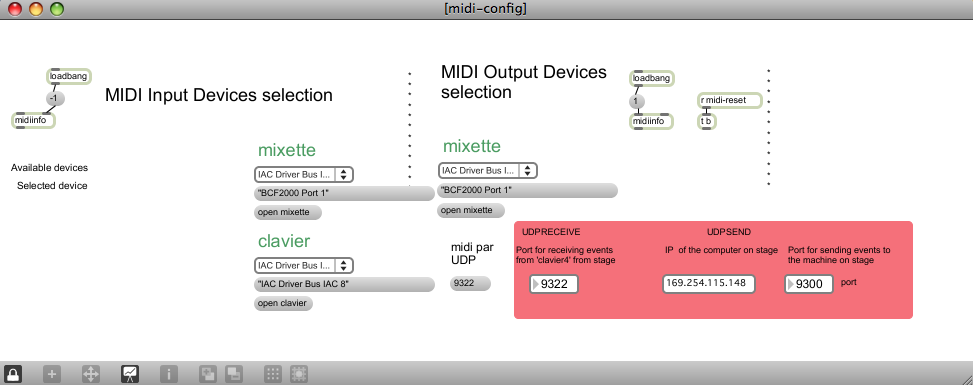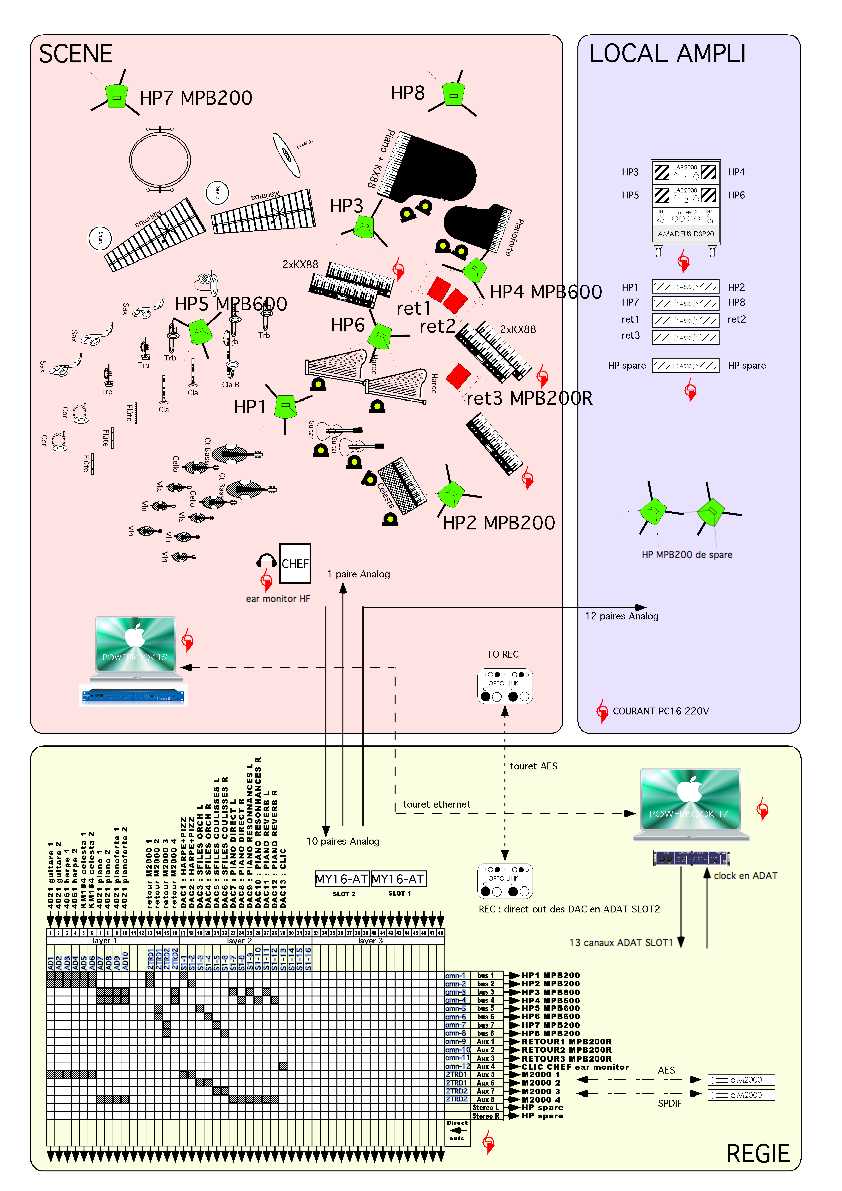Table of contents
Documentation date: 31 octobre 2013
Version state
Valid
Validation date: 3 mai 2018
Version documentalist
- tmays (tmays@ircam.fr)
Version realisation
- Maxime Le Saux (Sound engineer)
- Benoit Meudic (Computer Music Designer)
Version length
14 mnUpgrade Motivation
Max6
Detailed staff
- 3 flûtes (aussi 2 flûtes altos, 1 flûte basse [toutes amplifiées] ), 1 saxophone ténor, 1 saxophone baryton, 1 saxophone basse, 2 clarinettes, 1 clarinette basse, 2 cors (aussi 2 caisses-claires [vibrantes, abouchés aux 2 cors] ), 2 trompettes [abouchées aux deux cors] , 3 trombones complets (aussi 1 trompette basse [abouchée au tuba] ), 1 tuba, 2 marimbas (aussi 1 grosse-caisse, 1 tam-tam), 1 pianoforte [type copie Clark 1820 à 435 Hrtx, amplifié] , 2 harpes [accordées à 449 hrtz] , 2 guitares [accordées à 458 hrtz, amplifiées] , 5 claviers électroniques/MIDI/synthétiseurs [3 clavieristes] , 1 piano [accord 442 hrtz] , 1 célesta, 12 violons, 10 violons II, 8 altos, 6 violoncelles, 4 contrebasses
Electronic equipment list
Computer Music Equipment
-
1 MacBook Pro - Apple Laptops
(Apple)
Main computer, OS > 10.6.8 -
1 Macintosh G4 - Apple Desktops
(Apple)
for converting midi keyboard events to ethernet and for the ethernet communication (by osc) between stage and the main computer -
1 RJ 45 Cable - Cable
for osc communication between computer on stage and main computer -
1 Max 6 - Max
(Cycling74)
-
1 Fireface 800 - Sound Board
(RME)
-
5 KX 88 - MIDI Keyboard
(Yamaha)
-
1 BCF 2000 - MIDI Mixer
(Behringer)
-
1 Footswitch / Sustain Pedal - Footswitch / Sustain Pedal
for the 'clavier4'
Audio Equipment
-
8 Loudspeaker - Loudspeakers
see document LEVINAS_technique.pdf for repartition -
1 ear-monitor - Headphones
for click-track (used in the second part of the piece) -
1 DM2000 - Digital Mixers
(Yamaha)
Work related information
Premiere
- 6 mars 2009, Radio France, festival Présences
Publisher :
- Lemoine
Realisation
- Benoît Meudic
Work length
- 20 mn
Useful links on Brahms
- Évanoui pour un double orchestre (2009), 20mn
- Michaël Levinas
| File | Author(s) | Comment | |
|---|---|---|---|
| Download [35,5 Kio] | Document declenchements.pdf | ||
| Download [768,2 Mio] | Patch evanoui-max.dmg | ||
| Download [1,2 Mio] | Technical rider LEVINAS_technique.pdf | Maxime Le Saux | Stage Setup and DM1000 patch |
| Download [396,3 Mio] | Sound banks soundfonts-raw.dmg |
Instructions
Stage setup
The instruments are distributed in two groups (two orchestras). See document LEVINAS_technique.pdf for full information. The disposition that was adopted for the creation was inversed left-right when compared to the document.
Loudspeakers set-up:
The disposition of the loudspeakers is provided in the document ‘LEVINAS_technique.pdf’.
HP1 and HP2 are used for amplifying guitars and harps.
HP3 and HP4 are used for the diffusion of midi keyboards (clavier1, clavier3 and clavier4).
HP5 and HP6 are used for soundfiles ‘coming from the orchestra’.
HP7 and HP8 are used for soundfiles ‘coming from the backstage’ (event 84, 106, 123 and 166 - see document ‘repartition-soundfiles.txt’).
Introduction to the electronic part:
The electronic relies on 5 midi keyboards that trigger orchestral samples and soundfiles. The keyboards are distributed to 3 players:
- ‘clavier1’ plays two keyboard (one for viola pizzicatos samples and one for harp samples)
- ‘clavier3’ plays two keyboards (one for viola pizzicatos samples and one for harp samples)
- ‘clavier4’ plays one keyboard (piano samples and soundfiles).
For trigerring soundfiles, the instrumentist has to keep pressed the highest key (midi 108), then pressing the successive chromatic keys from C4 (midi 60) to A#5 (midi 82) will respectively trigger events (soundfiles) from bar 78 to 181. The score containing the keys that must be played by ‘clavier4’ for trigerring soundfiles is not included in the main score. You can edit and print it from the file evanoui/doc/declenchements.pdf. Don’t forget to give it also to the instrumentist and to the conductor.
Note: in the score, ‘clavier2’ is the name for the acoustic piano (442 Hz), and ‘pno’ is the name for the pianoforte
Some instruments also need to be amplified:
orchestra I: pianoforte, guitars, acoustic piano, harps
orchestra II: flutes
Patches installation:
On the main computer, you must launch 2 patches with max/msp and one standalone application ‘microton’:
- ‘evanoui’ is the main patch. It is used for playing soundfiles and for adding resonnances to the ‘clavier4’ (piano samples) signal output.
- ‘microton’ is the patch that plays the ‘clavier4’ samples
- the standalone application ‘microton’ plays the ‘clavier1’ and ‘clavier3’ samples
On the computer on stage, you must launch 1 patch with max/msp:
- ‘evanoui-mergermidi’ converts the midi keyboards input to osc and send the messages to the main computer.
Main computer:
Inputs/Outputs of the computer:
There are no inputs.
There are 15 outputs: respectively ‘clavier1’ (channels 1-2), ‘sfile orchestre’ (channels 3-4), ‘sfile coulisse’ (channels 5-6), ‘clavier4’ (channels 7-8), ‘clavier4-resonnance’ (channel 9-10), ‘clavier4-reverb’ (channel 11-12), ‘clavier2’ (channels 13-14), and ‘click-track’ (channel 15)
Installation:
Copy the folder ‘evanoui’ on your hard disk.
Launch max/msp, and select this folder (and only this one) in the ‘file preferences’ menu of max/msp.
Open the patches ‘evanoui’ and ‘microton’ in max-msp.

Description of the patch ‘evanoui’ (figure ‘evanoui’):
The patch is composed of:
- Top right: interface for events triggering (figure ‘events’). Events are represented by a number corresponding to the bar number reported in the instrumental score. The highlighted number in the menu corresponds to the next event that will be triggered. The event number in the big whit box corresponds to the current event.
- Top left: main sub-patchers (audio, midi, libraries, events counter, reset, matrix connections).
- Bottom: live mixing faders.

Description of the patch ‘microton’ (figure ‘microton’):
This patch is far more complex than needed for the concert, it was initially used for playing orchestral samples with microtonal pitches at various scales. It was not modified for the concert because who can do more can do less.
For the concert, choose the udp receive port (double-click on ‘p OSC-SETTINGS’ on the top right part of the patch). Then save the patch. The port will be recalled after initialisation even if you relaunch max in the meantime.
The patch ‘microton’ is initialised with a remote message from the main patch ‘evanoui’.
The patch ‘microton’ has not been integrated to the standalone ‘microton’ because the audio output of ‘clavier4’ must be sent to the main patch ‘evanoui’ in order to feed the resonances (‘resharmo’).
The two patches ‘microton’ and ‘evanoui’ are initialised from the main patch ‘evanoui’:

To Initialize:
0. bang to map dac outputs to channel outputs starting from 1 (you can modify the abstraction if you want to start from 13 for instance with a fireface)
1. Click on ‘1-load files’.
2. Click on ‘2-config’ to configure the udpsend en udpreceive parameters and the midi input/output control surface for mixing:
udpreceive: specify on which port you receive the events corresponding to’clavier4’
udpsend: if you want to test the connection between the main computer and the computer on stage, you need to provide the IP and the receiving port of the computer on stage
mixette input device and mixette output device: a control surface was used in order to move the soundfiles from the stage loudspeakers to backstage loudspeakers (first fader - finally not used during the concert) and to separately control the level of stage loudspeakers (fader 2) and backstage loudspeakers (fader 3). However, the levels can be adjusted direcly in the pattr presets for each soundfile during the rehearsal, so the surface controler is optional.
3. Click on ‘3-init’: resets all dsp and control modules, and sets overdrive on, dsp vector size to 64 and iovs to 128 (see screenshot ‘reset.png’)
4. turn the DAC on
5. Trigger the first event with space bar (event 0) before the concert starts. Check the click-track with the conductor (there is a toggle to start and stop it). During the concert, the click-track is automatically started on event 78 and  stopped on event 181 (triggered by ‘clavier4’).
stopped on event 181 (triggered by ‘clavier4’).
Description of the standalone application ‘microton’:
This is the standalone version of the patch ‘microton’. We used a standalone so that any modification in the main patch that would require restarting max/msp during rehearsal would not affect the keyboards ‘clavier1’ and ‘clavier3’. More details are provided in the ‘README’ of the patch (bottom right).
The standalone is a clone of the ‘microton’ patch, and thus the four output dac numbers start from 9: ‘dac~ 9 10 11 12’ (you can see it if you click on ‘p micro-play’ at the bottom middle). You must then make the correct mapping by hand in the ‘DSP status’ window (click on the message ‘dsp’ to open it).
The mapping should be:
dac9-10 channel 1-2
dac11-12 channel 13-14
(all the mappings are reported in the top right part of the main patch ‘evanoui’)
Note: the default input port for the standalone is 9321. You can’t change it unless recompiling the application.
Once you have launched the standalone and chosen the correct audio interface and mapping, click on ‘init’ to initialize and turn the dsp on. Then you should not have to care about it during all the concert.
Computer on stage:
 Copy the file 'evanoui-mergermidi' on your hard disk.
Launch the file in max/msp.
Copy the file 'evanoui-mergermidi' on your hard disk.
Launch the file in max/msp.
To initialize the patch:
1. choose the midi input for each of the keyboards (clavier1-1 stands for the viola piz samples, clavier1-2 stands for the harp samples and so on…).
2. choose the ethernet ip and ports for communicating with the main computer
Mixing instructions:
We have used a BCF 2000 for mixing of electronics with following mapping:
-> fader2 for sfile2, sfile23, sfile25 and sfile26
-> fader3 for sfile22 and sfile24 (sent to coulisse-loudspeakers, see below)
The levels of the keyboards should always be balanced with the acoustic instruments, in order to mix equally the timbres.
The level of the soundfiles should also be balanced. The soundfiles with a ‘marimba’ sound should be loud, and the soundfiles sent to the ‘coulisse-loudspeakers’ (bar 84, 106, 123 and 166) should appear as distant from the stage.
© IRCAM

This documentation is licensed under a Creative Commons Attribution-NonCommercial-NoDerivatives 4.0 International License.
Program note
L'écriture de cette partition est basée sur une polyphonie-timbre. Cette polyphonie-timbre est obtenue par des superpositions de tempi faisant évoluer des processus harmoniques et des agrégats complexes. Ces processus évoluent en appoggiatures qui laissent percevoir le déroulement d'échelles évolutives. Ces échelles s'altèrent et se démultiplient en phénomènes octaviants et brisés. (Voir l'ouverture des [work:22287][Nègres], mon [work:23523][deuxième quatuor], [work:23532][Incurver], [work:23528][Se briser]). L'orchestre symphonique tente dans cette pièce une mutation conséquente à l'évolution des langues musicales. L'identité originaire de ce que nous appelons « l'orchestre symphonique » résulte du système tonal et de la fin de l'époque baroque européenne. Dans cette pièce, l'apparition d'un groupe instrumental spécifique basé sur différentes familles de « cordes pincées », le pianoforte, la superposition de plusieurs diapasons, les interférences entre les sons propagés dans l'espace par l'acoustique « aérienne » des instruments (le piano notamment) et les sons instrumentaux échantillonnés, provoquent des mouvements résultants et des battements très mobiles.
Michaël Lévinas
Version documentation creation date: 31 octobre 2013 05:19, update date: 6 mai 2021 15:09
